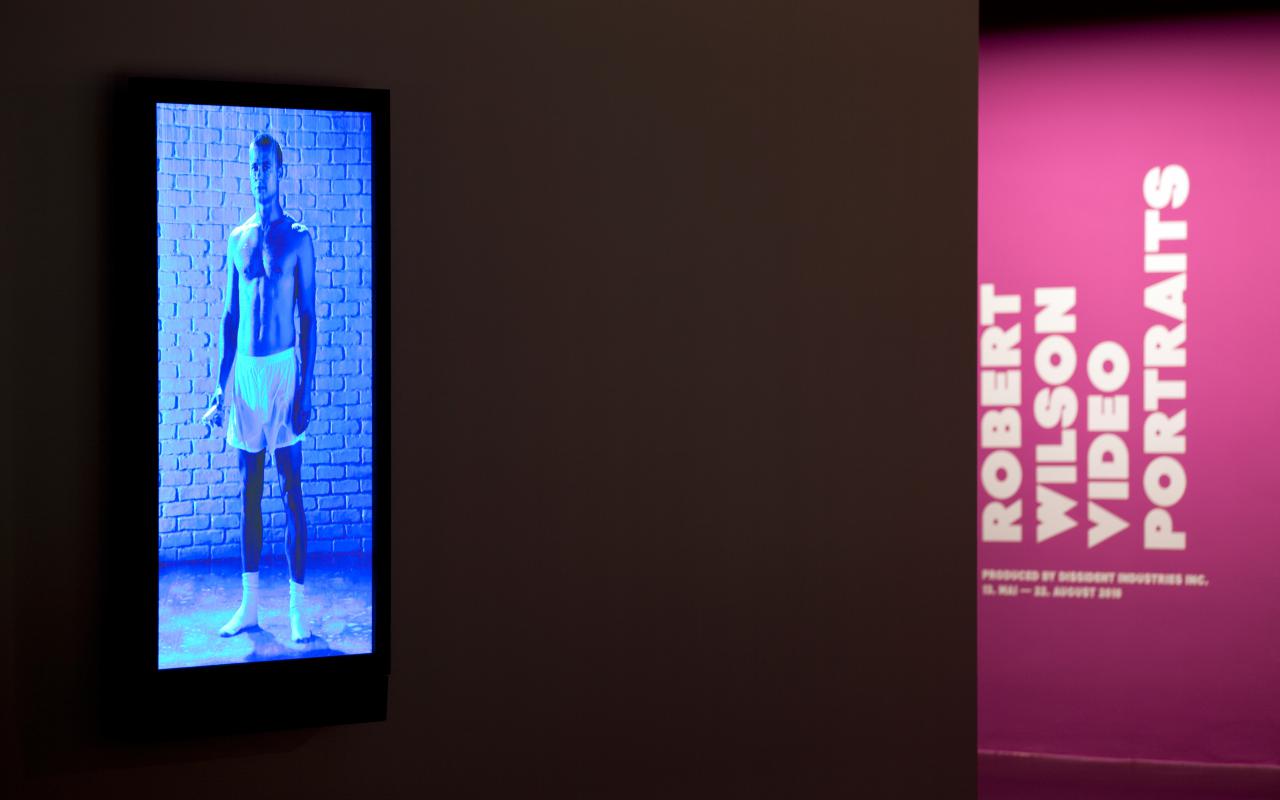Robert Wilson: Video Portraits

Thu, May 13, 2010 – Sun, August 22, 2010
Although Robert Wilson refuses to interpret his works, he gladly takes on the task of interpretation when it has to do with personalities. He created his first portraits of important personalities, such as Louis Aragon, Pontus Hultén, and Helene Rochas already in the 1970s. His portraits are theatrical stagings and in that, also interpretations. Wilson’s work as an artist is constructed from decisive artistic impulses of the 1960s (from Performance through to Minimal Art), which flowed into his epochal and legendary stagings beginning in the 1970s. Starting from his stagings, he also became a stage designer and sculptor, painter, and drawer. His visual art was, accordingly, not limited to surfaces; he also created three-dimensional objects, installations, and environments of the highest poetics, in part absurd and surrealist, in part extremely minimalist, but in all cases, surprising. With the time-based visual forms video and film he achieved an innovated visual language shaping a world between Chaplinesque and Kafkaesque, but was always absolutely Wilson.
Wilson has concentrated all of his experiences as worldwide celebrated visual and object artist, as stage designer and director, as choreograph and curator in his video portraits since 2004, as the technological possibilities of High Definition television allow him to differentiate the wealth of his pictorial and stage languages: movement, gesture, make-up, costume, scenery, lighting, as well as the style of high and pop culture, classical and also new media, painting, design, music, opera, dance, theater, photography, television, film, etc. The portrayed personalities here refer not only to their own biographical details, but also to cultural history. Thus, Robert Downey Jr., for example, presents the corpse of Rembrandt’s Anatomy of Dr. Nicolaes Tulp (1632) and Johnny Depp can be seen in drag, posing as Rrose Sélavy by Marcel Duchamp. The subjects are both constructed and authentic, biographical and socio-graphical, portraits of their lives as well as of a media and an epoch. The portraits are visual histories, but also part of history, or are themselves history.
Yet Robert Wilson does not portray only famous personalities, such as Isabella Rossellini, Brad Pitt, or Caroline von Monaco, but also unknown people and animals who have until now escaped artistic representation, such as a street dancer or a frog. In precisely these stagings, Wilson’s complex visual and sound languages reach their climax, namely, a celebration of empathy: anonymous people become divas, neutral beings achieve cult status. Wilson’s video portraits thus have a cognitive function. Within the history of portrait painting and photographic portraits, especially staged photography, his staged portraits present not only a pinnacle of accomplishment, but also, first and foremost, a climax that is groundbreaking.
Thus, as an essential component, every video portrait, goes beyond the scenic element, underscored by a sound carpet that can contain anything ranging from field recordings to video game music, from classical to blues, rock, and punk, or even Heiner Müller lyrics quoted by Robert Wilson.
After showing at the Neuen Galerie Graz and the Sammlung Harald Falckenberg in Hamburg, the exhibition at ZKM | Museum of Contemporary Art will show a selection of video portraits specially put together for the venue. A catalogue will be published for the exhibition at ZKM (ed. Peter Weibel) with contributions by Norman Bryson, Ali Hossaini, Noah Khoshbin, Matthew Shattuck, Nicola Suthor, Peter Weibel, and Robert Wilson.
Wilson has concentrated all of his experiences as worldwide celebrated visual and object artist, as stage designer and director, as choreograph and curator in his video portraits since 2004, as the technological possibilities of High Definition television allow him to differentiate the wealth of his pictorial and stage languages: movement, gesture, make-up, costume, scenery, lighting, as well as the style of high and pop culture, classical and also new media, painting, design, music, opera, dance, theater, photography, television, film, etc. The portrayed personalities here refer not only to their own biographical details, but also to cultural history. Thus, Robert Downey Jr., for example, presents the corpse of Rembrandt’s Anatomy of Dr. Nicolaes Tulp (1632) and Johnny Depp can be seen in drag, posing as Rrose Sélavy by Marcel Duchamp. The subjects are both constructed and authentic, biographical and socio-graphical, portraits of their lives as well as of a media and an epoch. The portraits are visual histories, but also part of history, or are themselves history.
Yet Robert Wilson does not portray only famous personalities, such as Isabella Rossellini, Brad Pitt, or Caroline von Monaco, but also unknown people and animals who have until now escaped artistic representation, such as a street dancer or a frog. In precisely these stagings, Wilson’s complex visual and sound languages reach their climax, namely, a celebration of empathy: anonymous people become divas, neutral beings achieve cult status. Wilson’s video portraits thus have a cognitive function. Within the history of portrait painting and photographic portraits, especially staged photography, his staged portraits present not only a pinnacle of accomplishment, but also, first and foremost, a climax that is groundbreaking.
Thus, as an essential component, every video portrait, goes beyond the scenic element, underscored by a sound carpet that can contain anything ranging from field recordings to video game music, from classical to blues, rock, and punk, or even Heiner Müller lyrics quoted by Robert Wilson.
After showing at the Neuen Galerie Graz and the Sammlung Harald Falckenberg in Hamburg, the exhibition at ZKM | Museum of Contemporary Art will show a selection of video portraits specially put together for the venue. A catalogue will be published for the exhibition at ZKM (ed. Peter Weibel) with contributions by Norman Bryson, Ali Hossaini, Noah Khoshbin, Matthew Shattuck, Nicola Suthor, Peter Weibel, and Robert Wilson.
- Credits
- Peter Weibel (Curator)
- Harald Falckenberg (Curator)
- Christa Steinle (Curator)
- Toni Stooss (Curator)
- Hubertus Gaßner (Curator)
- Exhibitions team
- Martin Häberle (technical project management)
Marianne Meister (registrar) - Organization / Institution
- ZKM | Museum für Neue Kunst
- Partners
Neue Galerie Graz, Universalmuseum Joanneum, Graz ; Sammlung Falckenberg ; Hamburger Kunsthalle ; Museum der Moderne Salzburg

